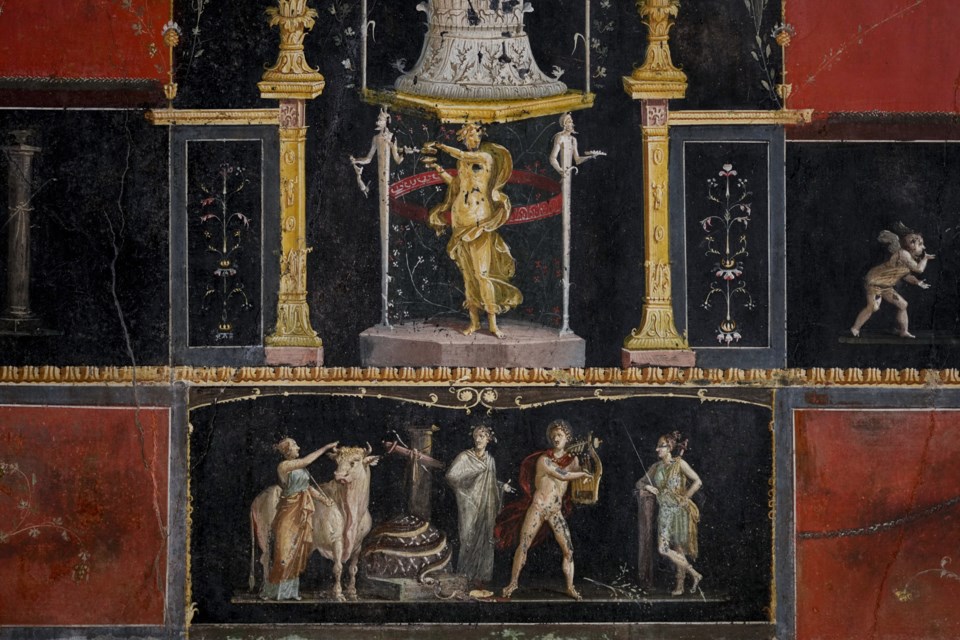POMPEII, Italy (AP) ŌĆö The newly restored remains of an opulent house in Pompeii that likely belonged to two former slaves who became rich through the wine trade offer visitors an exceptional peek at details of domestic life in the doomed Roman city.
On Tuesday, the House of Vettii, Domus Vettiorum in Latin, was being formally unveiled after 20 years of restoration. Given fresh life were frescoes from the latest fashion in Pompeii wall decoration before the flourishing city was buried under the volcanic ash furiously spewing from Mount Vesuvius in 79 AD.
The unveiling of the restored home is yet another sign of the rebirth of Pompeii, which followed decades of modern bureaucratic neglect, flooding and pillaging by thieves in search of artifacts to sell.
That is delighting tourists and rewarding experts with tantalizing fresh insights into the everyday life of what is one of the most celebrated remnants of the ancient world.
ŌĆ£The House of the Vetti is like the history of Pompeii and actually of Roman society within one house,ŌĆØ PompeiiŌĆÖs director, Gabriel Zuchtriegel, gushed as he showed off an area of the domus known as the Cupid Rooms last month.
ŌĆ£WeŌĆÖre seeing here the last phase of the Pompeian wall painting with incredible details, so you can stand before these images for hours and still discover new details,ŌĆØ the archaeological parkŌĆÖs energetic director told The Associated Press ahead of the public inauguration.
ŌĆ£So, you have this mixture: nature, architecture, art. But it is also a story about the social life of the Pompeiian society and actually the Roman world in this phase of history," Zuchtriegel added.
Previous restoration work, which involved repeated application of paraffin over the frescoed walls in hopes of preserving them, ŌĆ£resulted in them becoming very blurred over time, because very thick and opaque layers formed, making it difficult to ŌĆśreadŌĆÖ the fresco," said Stefania Giudice, director of fresco restoration.
But the wax did serve to preserve them remarkably.
Zuchtriegel ventured that the fresh ŌĆ£readingsŌĆØ of the revived fresco painting ŌĆ£reflect the dreams and imagination and anxieties of the owners because they lived between these images,ŌĆÖŌĆÖ which include Greek mythological figures.
And who were these owners? The Vettis were two men ŌĆö Aulus Vettius Conviva and Aulus Vettius Restitutus. In addition to having part of their names in common, they shared a common past ŌĆö not as descendants of noble Roman families accustomed to opulence, but rather, Pompeii experts say, almost certainly, as once enslaved men who were later freed.
It is believed that they became wealthy through the wine trade. While some have hypothesized the two were brothers, there is no certainty about that.
In the living room, known as the Hall of Pentheus, a fresco depicts Hercules as a child, crushing two snakes, in an illustration of an episode from the Greek heroŌĆÖs life. According to mythology, Hera, the goddess wife of Zeus, sent snakes to kill Hercules because she was furious that he was born from the union of Zeus with a mortal woman, Alcmena.
Might Aulus Vettius Conviva and Aulus Vettius Restitutus have recognized their own life story in some way in the figure of Hercules who overcame challenge after challenge in his life?
That's a question that intrigues Zuchtriegel.
After years in slavery, the men ŌĆ£then had an incredible career after that and reached the highest ranks of local society, at least economically,ŌĆÖŌĆÖ judging by their upscale domus and garden, Zuchtriegel said. ŌĆ£They evidently tried to show their new status also through culture and through Greek mythological paintings, and itŌĆÖs all about saying, ŌĆśWeŌĆÖve made it and so we are part of this eliteŌĆÖŌĆØ of the Roman world.
PompeiiŌĆÖs architect director of restoration work, Arianna Spinosa, called the restored home ŌĆ£one of the iconic houses of Pompeii. The residence "represents the Pompeiian domus par excellence, not only because of the frescoes of exceptional importance, but also because of its layout and architecture.ŌĆØ
Ornamental marble baths and tables surround the garden.
First unearthed during archaeological excavations in the late 19th century, the domus was closed in 2002 for urgent restoration work, including shoring up roofing. After a partial reopening in 2016, it was closed again in 2020 for the final phase of the work, which included restoration of the frescoes and of the floor and colonnades.
Francesco Sportelli, The Associated Press




